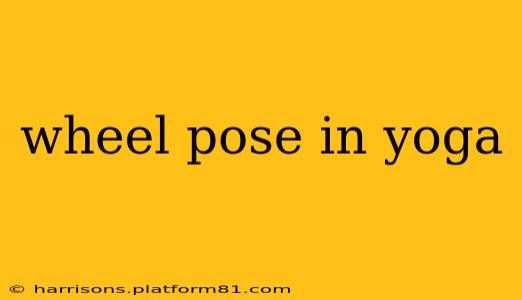The wheel pose, also known as Urdhva Dhanurasana in Sanskrit, is a challenging yet rewarding backbend in yoga. It opens the chest, strengthens the back, and improves flexibility throughout the entire body. However, it's crucial to approach this pose with caution and proper preparation to avoid injury. This comprehensive guide will explore the benefits, variations, modifications, and precautions associated with the wheel pose.
What are the benefits of Wheel Pose?
Wheel pose offers a multitude of physical and mental benefits. Physically, it:
- Strengthens the back muscles: The pose requires significant strength in the back, shoulders, and arms to lift the body off the ground.
- Opens the chest and shoulders: This counteracts the effects of prolonged sitting and improves posture.
- Stretches the hips, thighs, and ankles: Increased flexibility in these areas leads to improved balance and range of motion.
- Stimulates the abdominal organs: The deep backbend can aid digestion and improve circulation.
- Improves energy levels: The invigorating nature of the pose can boost overall energy and vitality.
Mentally, the wheel pose:
- Boosts confidence: Successfully holding the pose can be a significant confidence booster.
- Reduces stress and anxiety: The deep breathwork involved in the pose can help calm the mind.
- Improves focus and concentration: The pose demands concentration and body awareness.
How to do Wheel Pose Safely?
Approaching the wheel pose requires a gradual progression. Don't attempt it without proper preparation. Here's a step-by-step guide:
-
Warm-up: Begin with gentle stretches to warm up your body, focusing on the back, shoulders, hips, and legs. Child's pose, cat-cow, and downward-facing dog are excellent warm-up poses.
-
Bridge Pose: Practice bridge pose (Setu Bandha Sarvangasana) to build strength and flexibility in your back and shoulders.
-
Preparation Poses: Incorporate other backbends like upward-facing dog (Urdhva Mukha Svanasana) and camel pose (Ustrasana) to gradually increase your backbend capacity.
-
Positioning: Lie on your back with your knees bent and feet flat on the floor, hip-width apart. Place your hands palms down by your ears, fingers pointing towards your shoulders.
-
Lifting: Press into your feet and hands to lift your hips off the floor. Engage your core and try to keep your shoulders and hips aligned.
-
Deepening the Pose (optional): Once you're comfortable, gently deepen the backbend by pressing your feet firmly into the floor and straightening your arms.
What are the contraindications for Wheel Pose?
It's crucial to avoid wheel pose if you have:
- Carpal tunnel syndrome: The wrist extension can aggravate symptoms.
- Shoulder injuries: Pre-existing shoulder problems can be exacerbated.
- Neck injuries: The backbend can put pressure on the neck.
- Back injuries: This pose should be avoided if you have a history of back pain or injury.
- High blood pressure: The inversion aspect can affect blood pressure.
- Headaches or migraines: This pose may trigger or worsen headaches.
- Pregnancy: Avoid this pose during pregnancy.
How can I modify Wheel Pose for beginners?
Beginners can modify the wheel pose by:
- Using a yoga block or blanket: Place a block under your sacrum for support.
- Performing the pose against a wall: This provides stability and prevents overextension.
- Focusing on the bridge pose: Mastering the bridge pose first is crucial before attempting the full wheel pose.
What are some common mistakes to avoid in Wheel Pose?
- Forcing the pose: Never force your body into the pose. Listen to your body and stop if you feel pain.
- Not engaging your core: Engaging your core is essential for stability and preventing injury.
- Overextending your neck: Keep your neck relaxed and in alignment with your spine.
- Not warming up properly: A proper warm-up is crucial to prepare your body for this challenging pose.
What muscles does Wheel Pose work?
Wheel pose engages a multitude of muscles, primarily focusing on:
- Back muscles: Erector spinae, rhomboids, trapezius.
- Shoulder muscles: Deltoids, rotator cuff muscles.
- Chest muscles: Pectorals.
- Leg muscles: Quadriceps, hamstrings, glutes.
- Core muscles: Abdominals.
Remember, consistency and patience are key to mastering the wheel pose. Always listen to your body and modify the pose as needed. If you have any doubts or concerns, consult with a qualified yoga instructor before attempting this advanced pose.
